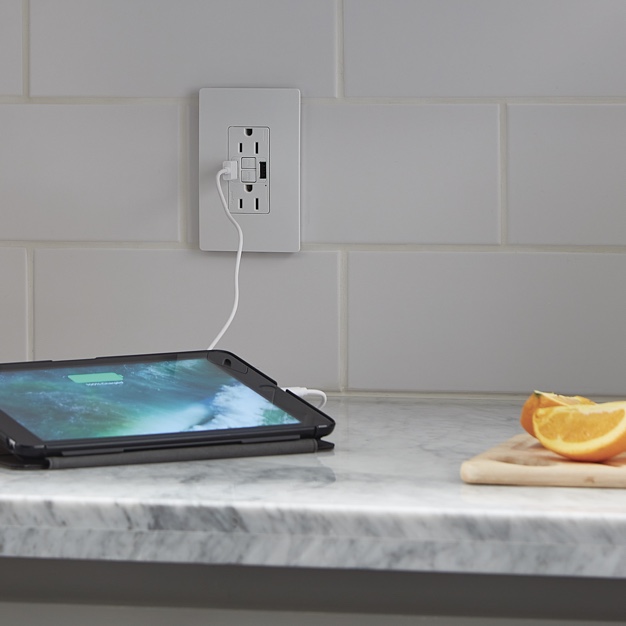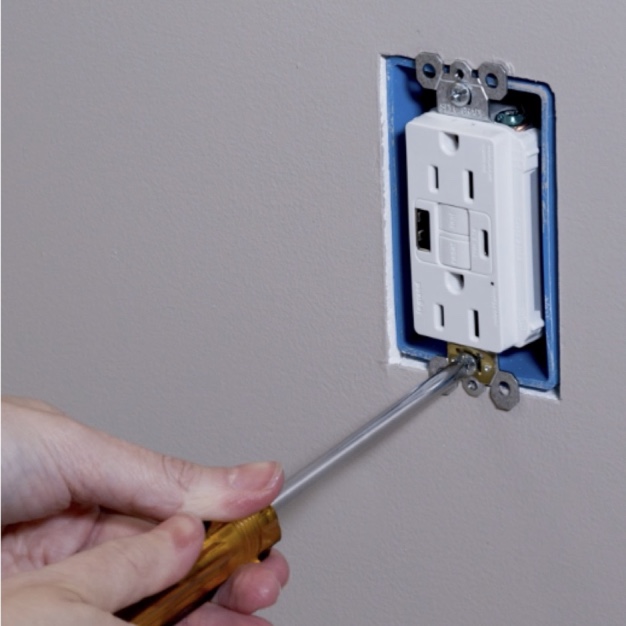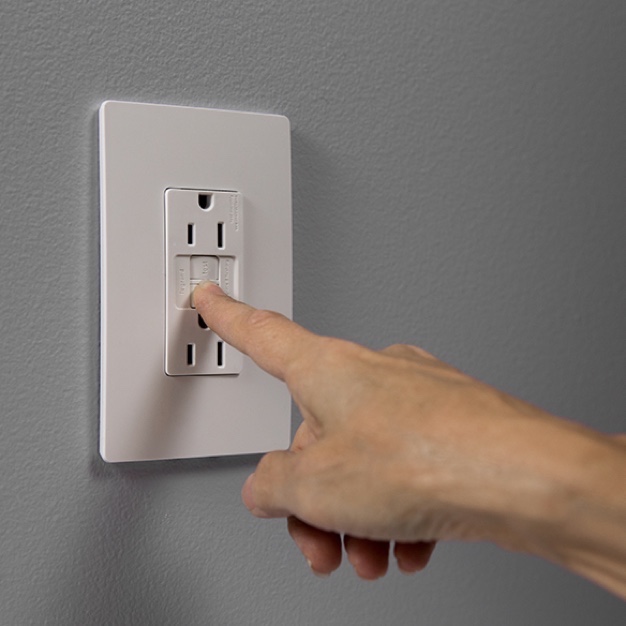The Electrical Safety of GFCI Outlets
A small device with big benefits, get to know your GFCI outlets and how their ground-fault protection helps keep you safe from electrical shock.
May 13, 2022Innovation has many drivers.
As a species, we have created, revamped and pushed forward for the sake of survival, for the advantages of convenience and ease, for our own enjoyment or the thrill of competition.
Sometimes, for the enhanced safety of all.
If we look around our homes today, so many details and items – many of which we might easily take for granted – were once new, novel, even groundbreaking inventions that brought additional safety to everyday lives. From the very first locks on doors centuries ago, to the early smoke alarms of the 1960s, to the high-tech security systems available now, generations of innovators have worked hard (and continue to do so) to make us safer and more protected.
In honor of National Electrical Safety Month, we’re taking a closer look at an example of one such innovation that happens to be near and dear to us: the GFCI Outlet.
Quick Review: What is a GFCI Outlet again?
For those unfamiliar, GFCI outlets are the ones with the two little buttons on the front. You very likely have a few in your home, specifically in the kitchen or bathroom (or laundry room, basement, etc).
Those buttons – labeled Test and Reset – aren’t just for fun. They relate to the GFCI outlet’s most important purpose: protecting you and your loved ones from electrical shock.
When you break down the name, GFCI stands for ground-fault circuit interrupter. A GFCI outlet’s job, in addition to providing power access, is to detect when a ground-fault occurs and immediately cut the flow of electricity.
That might sound simple enough, but it’s actually a pretty big deal.
When conditions are good and everything is in tip-top shape, you turn on an appliance and the power goes in a set path from Point A (the outlet) to Point B (your appliance) and it’s great. But electrical cords can loosen, crack or fray. Appliances get old or malfunction. And these are just some of the common conditions that give ground-faults a chance to do some damage.
As ground-faults occur when electricity takes an unexpected detour, that cracked cord or electrical wire lets electricity divert from its set path like it’s getting off on the wrong exit and the GPS is “recalibrating.” Suddenly, the flow of the electrical charge is off course without direction, and as the electric flow needs to keep going, it will look for any way to get to the ground – including a human being, resulting in painful even deadly electrical shock. This unfortunate risk of shock is even higher when in proximity to water (hence why the GFCI locations listed above are all rooms with sinks or potential dampness), because the water can be used as a conduit for the rogue electricity to reach a nearby person, even if they are not touching the appliance or cord.
However, when a GFCI is used, the above scenario is cut short. By interrupting that flow of electricity when the ground-fault occurs, a GFCI outlet “trips” thus preventing the electrical shock and indicating an electrical issue needs to be resolved before usage of the outlet or appliance should continue.
The aforementioned buttons play the critical roles of letting you regularly “test” your GFCI outlet to ensure it’s working properly and ready to protect you should a fault occur, and “reset” the outlet to restore power access once the issue has been resolved (electrical wire repaired, appliance replaced, etc).
Putting it in Perspective: GFCI Safety by the Numbers
Those buttons – labeled Test and Reset – aren’t just for fun. They relate to the GFCI outlet’s most important purpose: protecting you and your loved ones from electrical shock.
When you break down the name, GFCI stands for ground-fault circuit interrupter. A GFCI outlet’s job, in addition to providing power access, is to detect when a ground-fault occurs and immediately cut the flow of electricity.
That might sound simple enough, but it’s actually a pretty big deal.
When conditions are good and everything is in tip-top shape, you turn on an appliance and the power goes in a set path from Point A (the outlet) to Point B (your appliance) and it’s great. But electrical cords can loosen, crack or fray. Appliances get old or malfunction. And these are just some of the common conditions that give ground-faults a chance to do some damage.
As ground-faults occur when electricity takes an unexpected detour, that cracked cord or electrical wire lets electricity divert from its set path like it’s getting off on the wrong exit and the GPS is “recalibrating.” Suddenly, the flow of the electrical charge is off course without direction, and as the electric flow needs to keep going, it will look for any way to get to the ground – including a human being, resulting in painful even deadly electrical shock. This unfortunate risk of shock is even higher when in proximity to water (hence why the GFCI locations listed above are all rooms with sinks or potential dampness), because the water can be used as a conduit for the rogue electricity to reach a nearby person, even if they are not touching the appliance or cord.
However, when a GFCI is used, the above scenario is cut short. By interrupting that flow of electricity when the ground-fault occurs, a GFCI outlet “trips” thus preventing the electrical shock and indicating an electrical issue needs to be resolved before usage of the outlet or appliance should continue.
The aforementioned buttons play the critical roles of letting you regularly “test” your GFCI outlet to ensure it’s working properly and ready to protect you should a fault occur, and “reset” the outlet to restore power access once the issue has been resolved (electrical wire repaired, appliance replaced, etc).
Putting it in Perspective: GFCI Safety by the Numbers
Since the 1970s, the National Electrical Code has been requiring the use of Ground-Fault Circuit Interrupters in specific areas in and around the home, first in outdoor areas (1971) and bathrooms (1975). Over the next decade plus, these regularly updated national electric codes have added other required locations like garages (1978), kitchens (1987), basements (1987) and laundry rooms (2005).
As such, the number of electrocutions has dropped by 80% since 1975, with a bigger drop of 93% when looking specifically at electrocutions from consumer products we have in our homes. This incredible shift is directly linked to the required inclusion of GFCI protection in many residential spaces.
Plus, given the dramatic increase since the mid-70s in household electricity usage – both in terms of quantity and frequency – projections state that without the protection of GFCIs, we’d be looking at an increase of 1,118% in the number of consumer product electrocutions now.
As such, the number of electrocutions has dropped by 80% since 1975, with a bigger drop of 93% when looking specifically at electrocutions from consumer products we have in our homes. This incredible shift is directly linked to the required inclusion of GFCI protection in many residential spaces.
Plus, given the dramatic increase since the mid-70s in household electricity usage – both in terms of quantity and frequency – projections state that without the protection of GFCIs, we’d be looking at an increase of 1,118% in the number of consumer product electrocutions now.
For a more comprehensive look at the numbers, see the infographic created by Electrical Safety Foundation International below.
We’re proud to say that the first-ever GFCI outlet was introduced in the 1970s by our Pass & Seymour line. In addition to its incredible life-saving protection of GFCI technology, the GFCI outlet adds convenience and awareness by putting that GFCI protection at the point-of-use. Unlike circuit breaker options for GFCI protection, the outlets let you test, reset and check for trips right where you use the power. Explore our full offering of GFCI Outlets, complete with with designer style and advanced features, from the adorne® and radiant® Collections.
Related Articles
From features for superior safety to multiple options for convenient USB charging, find out what’s all inside this revolutionary GFCI outlet.
Put more within reach with this first-of-its-kind device – simply follow these easy step-by-step instructions for GFCI outlet wiring and installation.
Some common reasons, and resolutions, for electrical hiccups in your home.
lectrical safety tips and power saving products to help protect your home during extreme weather.





























